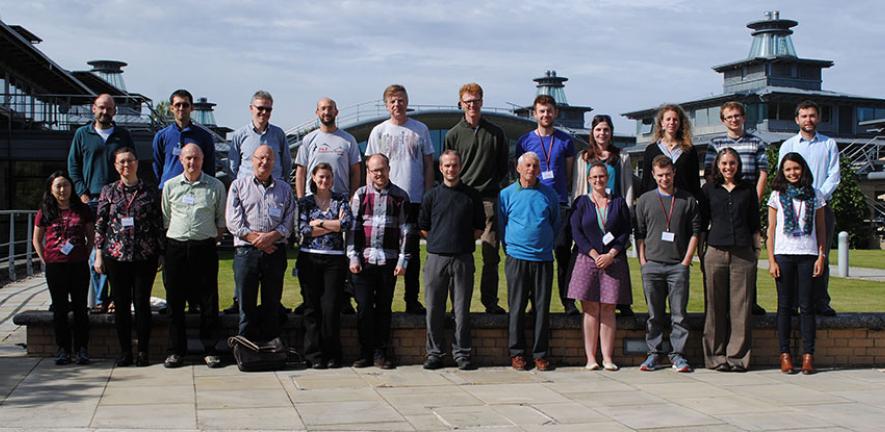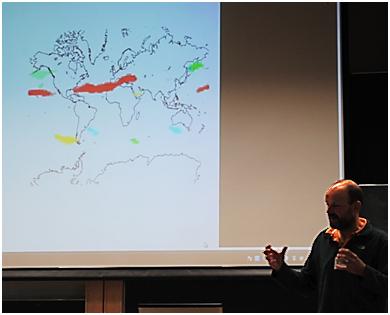
Regular updates were added while the event took place, to highlight the progress of each challenge.
The mitigation of severe environmental events and natural hazards is of increasing importance. Mathematical modelling and analysis has the potential to help address challenges identified in this area. Five industrial challenges have been posed by four organisations: JBA Trust, Fugro GEOS, the Met Office and the Environment Agency. These challenges involve both broad and specific issues relating to the application of models to predict and analyse environmental events. Over the course of four days, 45 mathematicians and environmental scientists worked to develop solutions (or partial solutions) to these challenges.
Monday 21st September
Each of the challenges from industry were presented, then delegates self selected which challenge to work on over the 4 day workshop.
Tuesday 22nd September
Click here to download non-technical descriptions of the challenges.
Wednesday 23rd September
Identification of Coherent Weather Features in Three Dimensions. The group working on the industrial challenge set by the JBA Trust are developing a strategy to identify sets of features within weather data. For example, they have developed a threshold value of eastward winds to help identify atmospheric fronts. Developing this strategy in two dimensions first forms a starting point for developing it for three-dimensional weather structures later. This strategy will enable them to develop a compact, efficient representation of coherent features akin to a solid shape.
Next steps: The group aim to measure similarity between weather features on successive days. This will help atmospheric scientists understand how weather features evolve through time.
Statistical Framework for Utilisation of Modelled Data for Tropical Cyclones. Every time ensembles are generated, there is stochasticity. To reduce this uncertainty, the group have been working on producing synthetic datasets, using Monte Carlo methods which use repeated random sampling to generate numerical outputs. The statistics generated from this approach can be used as a control with which to compare the results from the existing approach used by Fugro GEOS. The existing approach relies on ensemble forecasting of previously occurring individual storms, often from regions of high tropical cyclone frequency.
Comparing the two approaches using statistical tests will help the group to identify how close their models are to the ‘truth’, i.e. how realistic they are.
Spatial rainfall distribution in flood modelling. The group working on this challenge are seeking to develop ways in which the methods currently employed by the Environment Agency can be maintained, while simultaneously generating more detailed surface water flood forecasts and reducing the computational time involved. Since rainfall is not geographically constant, one approach is to redistribute sampling effort – and therefore computational time – by focussing flood modelling on areas of the UK which are most vulnerable to flooding and rainfall is least homogeneous. However, this method relies on rainfall being fairly uniform across a 5km x 5km grid square (the resolution at which flood risk is estimated under the existing method).
Next steps: The group are generating methods to identify the extent to which rainfall is homogeneous across 5km x 5km grid squares to verify the robustness of the proposed approach.
Adjustment of a Column of Convectively Unstable Moist Air. Moisture effects are fundamental to weather systems, yet modelling the effects of moisture on convection dynamics is inherently difficult. The group working on this challenge started by investigating whether the challenge was solvable, focussing their efforts first on generating a simple problem. Once this was agreed on, they made significant progress in solving this problem through mathematical analysis and numerical methods.
This approach will shed light on whether the effects of moisture controlled by large-scale information and are therefore predictable.
Validating Convective-Scale Rainfall Forecasts and Estimating their Uncertainty.
To calculate the displacement metric between predicted and observed rainfall patterns, the group applied two different approaches from other fields of study. This multidisciplinary approach may allow them to solve this challenge in different ways.
The first approach was to apply concepts from mass transportation theory; the study of optimal transportation and allocation of resources. This approach aims to define how far estimated rainfall patterns differ to observed rainfall, and in turn minimise the distance that the forecast rainfall needs to be adjusted.
The second approach is based on flow and image analysis; techniques employed in neuroscience. Both approaches aim to quantify the uncertainty surrounding these predictions and have the potential to help atmospheric scientists optimise the process of rainfall forecasting.

Thursday 24th September
Final discussions took place to prepare for the presentations from the groups on possible solutions to the industrial challenges.
Presentation of the Challenge Solutions
Summary of the Challenge Solution Discussions
Identification of Coherent Weather Features in Three Dimensions
Challenge proposer: JBA Trust
The group succeeded in their aim to develop Wednesday’s progress to 3D and 3.5D (repeated sequences through time), and gave a proof-of-concept demonstration showing that this is possible for 4D. Ultimately, their goal of visualising weather features through a vertical structure has been achieved. While atmospheric scientists have previously required humans to identify groups of weather features moving through time, the group have made significant progress in replicating this human brain processing using computers to recognise sets of pixels connected in space and time.
Next steps: This work may provide a basis for the identification of other sets of weather features in 3D and 4D, potentially revolutionising the way scientists predict events using atmospheric data.

Statistical Framework for Utilisation of Modelled Data for Tropical Cyclones
Challenge proposer: Fugro GEOS
The group had been using existing cyclone data and synthetic datasets to estimate maximal wave heights and wind speeds for predicted cyclones occurring in the Bay of Bengal and North West Australia. They have developed a strategy which enables them to do this with a degree of confidence. The number of observed cyclone data and the number of simulations required for these predictions can be adjusted depending on the client’s requirements and resources.
Next steps: Examine the effects of sea surface temperature and sea level pressure on tropical cyclone models.

Spatial rainfall distribution in flood modelling
Challenge proposer: Environment Agency
The group have developed a novel combined screening approach to help users redistribute computational and human resources for greater return. The assessment matrix below shows that greater effort can be allocated to modelling areas of high flood damage risk and heterogeneous rainfall, with reduced effort in other areas. Areas of non-homogeneous rainfall can be identified using both radar and measured rainfall data.
This tool has been purposely designed for non-expert users, increasing the potential uptake of this approach in industry.

Adjustment of a Column of Convectively Unstable Moist Air
Challenge proposer: Met Office
The group continued to investigate the problem of convection in a column. Moisture has non-trivial effects on weather systems, yet the addition of moisture in convection models is poorly understood due to complexities in the release of latent heat during condensation. By working first on the problem using a dry air model and then considering the effects of moisture, the group have gained an understanding of the optimal rearrangement of blocks of moist convection and developed numerical and analytical solutions to model this.
Next steps: Further refinements to the numerical solution, which can then be used by atmospheric scientists to validate moist air convection models.
Validating Convective-Scale Rainfall Forecasts and Estimating their Uncertainty
Challenge proposer: Met Office
The group developed the displacement approach, based on Trouvé & Younes (2005), to smoothly optimise predicted rainfall patterns. This resulted in the production of an interpolating rainmap in both 1D and 2D.
Next steps: Improve the formulation further to converge better with discontinuous data and apply this technique to real data. Since rain preferentially falls over elevated regions, the topology of the area of interest needs to be considered within this framework.
Reference: Trouvé, A., & Younes, L. (2005). Metamorphoses through lie group action. Foundations of Computational Mathematics, 5(2), 173-198.


